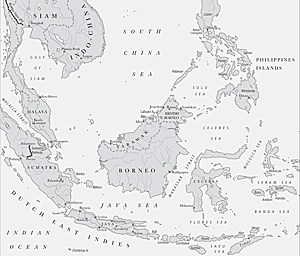
A brief history of the Far East Prisoners of War (FEPOWS)
The fall of Singapore and Java – capture of the FEPOWs
In spite of the swiftness of the advance of the Japanese armed forces down Malaya and their capture of Singapore, many of the Allied forces there were able to escape southwards to Java. British forces sent at that time for the defence of Singapore had therefore to divert to Sumatra and Java, hopefully to stop the further advance of the Japanese in their intention to invade Australia. On 28th February 1942 the Japanese landed on the west coast of Java and on 9th March the Netherlands East Indies army surrendered, thereby committing tens of thousands of British Army, Navy and Air Force personnel to their fate as prisoners of the Japanese. Subsequently for three and a half years those prisoners were to suffer exhausting labour, vicious punishment, starvation, disease and death in Japanese prison camps scattered all over the Far East.Japanese brutality towards their captives
It is well known that Japan had never ratified the Geneva Convention agreement prior to the Second World War and therefore perceived that they had carte blanche to treat their captives and enslaved subjects as they wished. The Japanese military had already been responsible for mass atrocities in China during the 1930s such as the Rape of Nanking. Under the government of the day, led by the premier Hideiki Tojo, recruits to the military were both ill treated by their superiors and encouraged to commit acts of brutality. Possibly inured to the abysmal nature of the violence they were allowed to exert upon civilian as well as military captives, many members of the Japanese armed forces were becoming accustomed to cruelty. By the time Allied soldiers, airmen and sailors fell into Japanese hands this appeared to be accepted behaviour in their ranks.
The atomic bombs on Japan
The two atomic bombs that were dropped on Hiroshima and Nagasaki by the US are widely believed by FEPOWs to have been their saviour, providing a narrow escape from the planned extermination that would have befallen them had the Allies had to rely upon a long drawn-out invasion of the Japanese homelands to secure a victory. Eventually reunited with their families, the skeleton-like survivors largely found it impossible to “describe the indescribable” and unburden themselves of their torturing memories.
Tortured memories
Unfortunately, many ex-FEPOWs struggled with these memories until their dying day and were never able to talk to anyone about their experiences, particularly not to their close family. Vivid, recurring nightmares, phobias, depression and guilt are just some of the problems with which they had to grapple. Others, often via chance contacts between erstwhile survivors, joined clubs and associations, which sometimes provided a cathartic effect because the shared experience of three and a half diabolical years allowed for mutual understanding.
The decision of most returning prisoners in late 1945 not to discuss their diabolical experiences with their loved ones, was born of consideration for the sensibilities of those close to them, as well as the notion that they would not be believed: How could a civilisation comprehend such barbaric treatment at the hands of another so-called civilised nation?
Stiff upper lip
By late 1945 when most of the FEPOWs had been repatriated, Britain had a new Labour government, the war in Europe had been over for several months, and the people of this war-ravaged island were doing their best to put the conflict behind them. Therefore, there was nothing for the ex-FEPOWs to do but to try to continue with their lives, and this meant not discussing their experiences, which they were loath to talk about in any case. In Britain, far less was known about the war in the Far East than the war in Europe. In addition to this, at the time there was also an undercurrent of shame associated with the fall of Singapore and its consequences in the Far East, which had been such a disaster for Churchill in 1942. It was only decades later that history was reviewed to take account of the poor leadership and lack of preparedness that led to Singapore’s easy capture, thus rightly exonerating the servicemen who were sent to their fate in this theatre of war as a result of their leaders’ lack of awareness of the severity of their predicament, the absence of good military intelligence and planning and the serious paucity of defences and military material.
